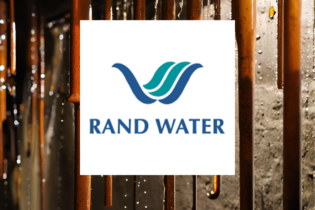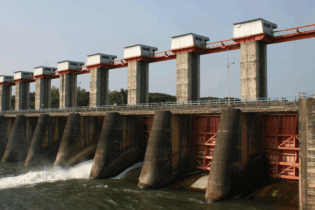Historically, electricity efficiency measures have not been a priority in the South African water industry due to the relatively low cost of electricity. Over the past 5 to 10 years this situation has rapidly been changing due to the increased demand, lack of electricity generating infrastructure and subsequent increase in electricity costs. Energy will in future remain a high-cost item for municipalities and utilities which operate and maintain water and wastewater processes.
Energy consumption continues to increase as more people are provided with water and sanitation and new technologies are implemented to meet stricter effluent and potable water quality requirements. The WRC presented the findings of the South African Energy Compendium of Good Practice in Water and Wastewater at the 4th Municipal Water Quality Conference, Sun City, on Tuesday 9 July 2013. To position the water sector globally with regard to energy consumption, the Global Water Research Coalition (GWRC) has embarked on a project entitled Energy Efficiency in the Water Industry: A Compendium of Best Practices and Case Studies, which documents these best practices worldwide. The project is supported by the GWRC partners as represented by the four Continental Coordinators, in Australasia (Australia and Singapore), Europe, South Africa and the USA. Each continental group has produced a report of best examples submitted by utilities in their region. When all four continental reports are available, they will be compiled into the global compendium. The WRC therefore commissioned a study to help understand the potential impact that current energy supply challenges are having on South Africa’s water and wastewater services. The project was to provide the South African water and wastewater treatment sectors with an objective and logical evaluation of the current and expected impact and consequences of power outages on water and wastewater treatment services. According to Dr Jo Burgess, WRC Research Manager, contrary to the UK and US Energy Compendia, South Africa has not been actively pursuing and implementing energy savings projects on a large scale, mainly as result of the abundance of readily available and cheap electricity in the country. This means that case studies and operational data are not readily available. In cases where energy savings applications have been made, the data are poorly recorded and not verified. Hence, the South African Compendium may need to be developed to guide towards best practice of ‘developmental industry’, as opposed to being a compendium of best practice by way of case study documentation. When demand has outstripped supply there has been a need for load shedding. In particular, power outages were experienced between November 2007 and January 2008 and have again been applied in 2013. Says Dr Valerie Naidoo, WRC Research Manager, South Africa has one of the most advanced water and wastewater sectors on the continent. Understanding the complexity of South Africa’s water supply chain is a critical component of analysing the impact of power outages on this sector. Numerous factors influence the amount of energy utilised in the water supply chain, including the stage of the water supply chain, technology utilised, the use of pump or gravity feeds and the quality of the water being treated. It should be noted that certain treatment technologies consume more energy than others. For example, reverse osmosis membranes use significantly more energy than other filtration techniques. “Up to 50% energy savings have been demonstrated by case studies in wastewater processes focused on aeration. Simple changes in control methods and set points have frequently shown substantial quick wins and checks on plant, control methods, operational routines and maintenance have proven worthwhile,” comments project leader Dr Marlene van der Merwe–Botha.One of the WRC-funded studies investigated and demonstrated the potential hydropower generation in pressurised water supply conduits. A pilot installation was erected at the Elardus Park Reservoir (Tshwane Metropolitan Municipality). The initial results reflected the benefit and expected return from such an investment, even if the system is only operated at a duty of 50%.
eThekwini Metropolitan Municipality conducted a feasibility study on the Northern Aqueduct in the Durban potable water distribution system. This project is fairly complex, consisting of 39 reservoirs, and water demand is often in danger of exceeding the supply. The feasibility study was based on the installation of six mini-hydrogenerators, each capable of providing150 to 180 kW. Based on this study, invitations for tender were put out by eThekwini Metro for six turbines. However, these were going to cost in the region of R35 million, which was deemed too expensive, and as a result the specifications of the tender were modified in order to reduce costs. The modified request for tender was for two turbines, but, to date, the Council has rejected this option. The cost of these turbines is expected to be between R6 million and R8 million each. In the meantime, eThekwini Metro is exploring the option of funding from Eskom, the national electricity supplier. Eskom has projects in which electricity generation of between 1000 kW and 1 MW are funded at a rate of R0.70/kW for a period of 3 to 5 years after commissioning. Should this funding be obtained, the project for two mini-hydro-generators in the Northern Aqueduct is expected to go ahead. Rand Water and Bloem Water are others pursuing this option, with Bloem Water progressing towards installing a 150 Kw unit in the next few months which will supply electricity to its headquarters. Another WRC project recognised opportunities that exist to improve the current wastewater treatment processes by applying new solutions and technologies that can reduce energy inputs or generate energy. A WRC survey conducted in 2009 on the quality and quantity of wastewaters in South Africa identified the top three sectors with the greatest potential energy recovery as: the formal and informal animal husbandry sector (cows, pigs and chickens); fruit and beverage industries (distillery, brewery, winery, fruit juicing and canning); and domestic backwater (sewage). Through this an estimated 10 000 MWh can be recovered from wastewaters in the whole of South Africa, representing 7% of the Eskom electrical power supply. Energy has also become a key driver in the wastewater treatment value chain of the City of Johannesburg and every effort is being made to produce “green energy” and reduce power consumption. Johannesburg Water operates and maintains six wastewater treatment works and treated about 1 054 000 m3 of sewage per day in 2010. All of the sewage treated was by the activated sludge process and about 90% of the 260 dry tons of sludge produced per day consisted of waste activated sludge. It is estimated that by 2020 the cost of electricity for the treatment of wastewater in Johannesburg will have risen from R97 million per annum to more than R300 million per annum, making the existing wastewater treatment operation possibly unaffordable. Failure of the wastewater treatment operations would have a devastating effect on the economy, environment, health services and social activities of the city. In line with the Department of Energy’s (DoE) Integrated Resource Plan of 2010, South Africa needs to increase its capacity by 45 000 MW by 2030. This figure excludes Eskom’s present capacity expansion projects. Amongst the list of recommendations made is that municipalities should look into energy savings opportunities by means of an energy audit. Such audits require plant operational data and monthly electrical accounts for the plant. Drawings and data of electrical equipment will ease the process of such an assessment. The price structure of the plant’s electrical account will benefit in understanding the cost structure for the waste water treatment plant (WWTP) during assessment stages. Issues such as electrical load management during peak demand periods must be clear and understood by the plant operations staff.Energy savings opportunities from demand side management (DSM) programmes include reduction in energy costs by shifting the power consumption from “on-peak” to “off-peak” hours. Such options need careful consideration for large treatment plants. Small and seasonal WWTPs may benefit from such an opportunity. A copy of WRC Report no. TT 565/13 can be downloaded from the WRC Knowledge Hub (www.wrc.org.za) or order a free print copy from the Publications Office orders@wrc.org.za






